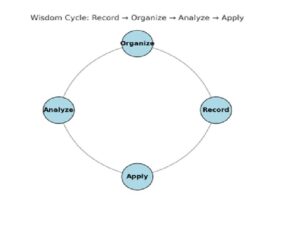Record to wisdom cycle
To understand the source of knowing, it is useful to introduce the concept of the Record-to-Wisdom Cycle. This framework describes how individuals or organizations can move from raw experience to actionable wisdom through a deliberate and repeating process. The cycle consists of four stages:
-
Record – The foundation of the cycle begins with capturing experience in its rawest form. Events, activities, and observations are documented as records—whether in notes, logs, databases, or memory. These records are the seeds of knowledge.
-
Organize – The next step is to structure these records so they are accessible and meaningful. This involves categorization, indexing, or creating systems—digital or otherwise—that allow information to be retrieved and connected. Organization transforms isolated records into navigable resources.
-
Analyze – Once organized, records can be examined for patterns, relationships, and insights. Through analysis—statistical, comparative, or interpretive—information begins to reveal meaning. At this stage, information becomes knowledge: structured understanding of “what is.”
-
Apply – The final step is the application of knowledge in practice. Decisions are made, problems solved, innovations created, and actions taken. When knowledge is applied with discernment, context-awareness, and foresight, it grows into wisdom.
Knowing vs. Knowledge
It is important to distinguish knowing from knowledge.
-
Knowing is a process: the act of seeking, questioning, interpreting, and making sense of information.
-
Knowledge is the product: the consolidated outcome of that process.
In other words, knowing is the journey; knowledge is the destination reached along the way.
Knowledge in Context
Knowledge can be understood as a multi-dimensional view of information, just as information itself is a multi-dimensional view of records. Each record captures only a slice of reality, but when multiple records are organized in database and analyzed, they provide richer and deeper dimensions of understanding.
The more we extract, connect, and reinterpret these records—both past and present—the closer we come to wisdom. In technical terms, this resembles the ETL process used in data science: Extraction, Transformation, and Loading. Yet, beyond the technical, it is also a human process: extracting meaning, transforming understanding, and loading wisdom into decision-making and action.
Hence, below is a schematic illustration of the process of knowledge Discovery from Databases (KDD). (Source: Fayyad et.al, 1996,p27-fayyad.pdf (uhcl.edu) )

KDD emphasize “knowledge” is the end product of a data-driven discovery” (Knowledge Discovery and Data Mining: Towards a Unifying Framework (aaai.org). As much as information is a multi-dimensional view of a record presented through databases, knowledge is a multi-dimensional view of information. Each piece of information which is a multi-dimension view of a record can tell us one dimension of the information.
In these website, we will explore the key components of the primary sources of knowing including recording, extracting, transforming and transferring.

The Evolution Toward Wisdom
The Record-to-Wisdom Cycle is not linear but circular. Each application generates new experiences, which become new records. Over time, the repeated practice of recording, organizing, analyzing, and applying not only builds knowledge but also cultivates wisdom—the capacity to synthesize, experience, and reflect to act in ways that are not only effective but lead to new and novel solutions.
This is where wizening starts.